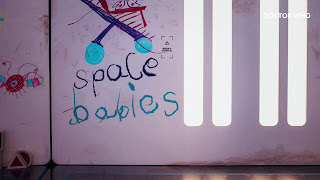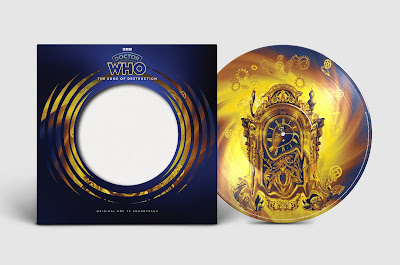I have a lot of problems with 'The Devil's Chord'. It's a very atypical
Doctor Who story in many senses, and while it is enjoyable to watch, the moment you start to look more closely, you realise that there's actually not much substance here.
It's a mishmash of scenes which have been put together in order to service a few key elements which, while they sound good on paper, actually don't make an actual story.
There's the Beatles, of course, one of the most popular singing groups of all time.
Let's have the Beatles in the show, but they don't look anything like the Beatles from 'real life', and (presumably) because we can't use any of their actual music, we'll make them be affected by the world having lost music - and that's what the Doctor needs to try and fix.
So why has the world lost music? Seems to be because back in 1925, a music teacher played something called the Devil's Chord ... which summoned an entity calling themself Maestro, who proceeded to remove/destroy all music from the world as a precursor to trying to destroy all music everywhere.
Interesting, though, that in 1925, there's a knowing child called Henry Arbinger (Harbinger) who is a prelude to Maestro's arrival - so the Gods knew that this teacher would play the chord? Or did they make this happen somehow - was Maestro ALWAYS going to appear at this point? And the Doctor was ALWAYS going to have to sort it out?
And to play the character of Maestro (they/them) we have a larger than life Drag Queen character, Jinkx Monsoon (she/her), who, frankly, is superb! Her (Jinkx's) lips curl and quiver and she eats up the scenery like no other! No mention that the character of Jinkx is actually performed by a person called Hera Hotter (they/them), but then this is no different from any other actor who has changed their name for a screen persona (like John Pertwee, Peter Moffett, Percy James Kent-Smith, David McDonald or even Mizero Gatwa to name a few). Whatever the reasoning, the performance is amazing, over the top, and a joy to watch!
Maestro, presumably because they own and can control music or some such, plays the
Doctor Who theme on the piano and we go into the titles with that. Then as we come out of the titles, the theme is playing on the record player on the TARDIS. This is very Meta, and this 'meta-ness' is something which isn't really
Doctor Who!
Anyway ... Back in 1963, the Doctor and Ruby have arrived to see the Beatles perform, but realise quickly that they can't as there is no good music. The news in the newspaper is wrong as well (and one-to-watch actress Susan Twist is playing a member of the canteen staff!) - something has changed history. I liked the use of a proper sixties song here - Marlena Shaw singing 'California Soul' (which was released on the 1st January 1969 - so we're a few years adrift from 1963).
The Doctor gets Ruby to play the piano (why it had to be up on the roof I don't know) which summons Maestro as they own all the music, which terrifies the Doctor as he realises he can't fight them. I liked that Maestro announces their presence with the Giggle - a seven note refrain which the Toymaker used in 'The Giggle' to send everyone on Earth mad.
But there's June Hudson, ex BBC Costume Designer famous for designing the Fourth Doctor's iconic outfit, here playing an old lady, and she gets killed by Maestro for daring to play the piano.
In a show which is currently wall to wall Murray Gold music - which is actually very intrusive. Can't we have some quieter scenes sometimes without the music 'telling' us what to think and feel at every turn? - it was a breath of fresh air when the Doctor uses his sonic device to dampen all sound, and we have scenes in complete silence. Very well done! Even Maestro applauds this move! I did say the episode was enjoyable!
Then we learn that Maestro is one of the pantheon of Gods, like the Toymaker is/was, and is all powerful. Cue a rerun of a scene from the seventies story 'Pyramids of Mars' where the Doctor takes Ruby back to her own time, which is now a nuclear wasteland - this is what will happen if they don't stop Maestro.
But ... wait ... hang on ... in the very last episode didn't we see the Doctor basically warning that we cannot change history - stepping on a butterfly in the past can change the future? Well this is the same thing isn't it? Maestro has killed music and so changed the history that the Doctor and Ruby knew. But a lot of other things could be a lot better perhaps? Maybe the Doctor is happy to change history if he doesn't remember or know what that history should have been or resulted in in the first place? So he's shaping history to fit his own memories is he?
Another thought. If all this Gods business is because the Doctor spilt some salt at the edge of time in 'Wild Blue Yonder' as has been suggested, then why not take the TARDIS back there and clean it up? However, Susan Twist (her again) cropped up in a prelude to 'Wild Blue Yonder' as Newton's maid, so maybe the salt-spilling actually has nothing to do with any of this!
But the Doctor doesn't have time to consider these history changing actions as he and Ruby are taken into the Maestro's realm (much as he was whisked into the Toymaker's realm in 'The Giggle') and the Doctor realises that a different chord would banish them. (Incidentally the TARDIS is groaning by this point).
So the Doctor is off to try and find the chord, but Maestro captures Ruby using some 'living' notes and annotated staves, and the Doctor and Maestro then have a music battle. I'm not making this up, honestly.
This is The Mask crossed with Tom and Jerry as the Doctor and Maestro slug it out, with physical notes hanging in the air and Maestro using a stave as a whip ... the piano is thrown into the corridor with the unfinished chord hanging above it while Ruby is trapped in a double bass and the Doctor in a drum!
Just when we think it's all over for the Doctor, John Lennon and Paul McCartney arrive and play the chord on the piano, adding the missing note. Maestro is dragged into the piano again and leaves with a warning that 'The One Who Waits is almost here!' and then they're gone!
Music is back, and on a big billboard on top of the building there's a poster advertising Chris Waites and the Carollers' new single (this is a reference to the very first episode of
Doctor Who in 1963 where Susan (the Doctor's granddaughter, who they spend a long time setting up and explaining in this episode) was listening to a single by John Smith and the Common Men (John Smith was the stage name of the Honourable Aubrey Waites. He started his career as Chris Waites and the Carollers).) We don't know what was on this poster before the music returned as we didn't see it.
You can hear that single online here: https://youtu.be/WVrH0SRTDUY. It's quite good.
Anyway ... Music is back and the episode is over ... except ... for an inexplicable reason, the Doctor and Ruby break into song and dance with a hoard of dancing extras, including people in wheelchairs, all hand jiving and dancing and flipping themselves over and over - it's like the start of Austin Powers International Man of Mystery! The song is 'There's Always A Twist At The End' ... but on this occasion, there isn't! Is that ironic? They are doing the dance The Twist though, so maybe that's what it's about.
But wait ... watching from a doorway is Henry Arbinger - but wasn't he killed/vaporised/vanished by Maestro back in 1925? There's something strange going on ... if he's back ... Maybe he's the twist?
The song and dance is over, and the Doctor and Ruby return to the TARDIS, where the Pelican Crossing is inexplicably now musical and lights up with sounds as they cross it.
So.
It's entertaining. It's watchable. But there's barely a plot in there. Maestro removes music from the world and the Doctor has to defeat them to bring it back. It's sort of the same in a way as 'The Giggle' where the Toymaker has filled the world with the Giggle, and the Doctor has to defeat him to return peoples' sanity. Along the way stuff just happens
There are numerous fourth wall breaking winks and asides from Maestro, not to mention the aforementioned Doctor Who theme music element ... plus the spontaneous song and dance. It's all great fun, but it's not Doctor Who! They just about got away with it with the Goblin Song in 'The Church on Ruby Road' as there was an in-story reason for that to be there ... but here? It's just tacked on the end as though they were running short by 3 minutes or so and needed to fill the time!
Doctor Who always succeeded over some other science fiction shows because while some of what it presented was, frankly, ridiculous, everyone always played it straight. Consider certain episodes of Lost in Space where the cast can't keep straight faces and Jonathan Harris is increasingly hamming it up (I love that show too, by the way)! There were no real instances of knowing overacting in Doctor Who (Derek Francis in 'The Romans' or Paul Darrow in 'Timelash' perhaps? Your mileage may vary) and the drama always came first. Here we have a story where the spectacle comes first, with the drama way down the list.
Maybe this has something to do with season arcs or whatever. Maybe it's the nature of these 'Gods' to want to behave over the top and manic, to the extent of twisting the Doctor's reality so that he is an actor in a TV show ... maybe? But that's not explained on screen. At least not here. Maybe it's the Toymaker's influence? Maybe it's that ridding the world of Maestro has brought music back, but all in a bang, so people can't help dancing and singing, and that the physical elements on Earth become infused with the 'magic' and take on musical life of their own? Again, not explained.
Overall its not my favourite episode of this new series by a long chalk, but there's still an awful lot to enjoy about it. Traditionally a series would try and 'bury' less successful episodes somewhere in the run - ie not putting them first or last - and maybe that's what happened here. Place this second, and hopefully people will have forgotten it by the time the end rolls around. I've no idea!














































